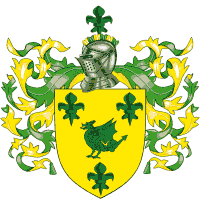

 |

|
|
|
|
|
|
Robida Coat of Arms
The Distinguished Surname Robidas Coat of Arms A gold shield with a black rose.
Heraldry emerged in France in the mid-12th
century, beginning with the knights and nobility choosing coats of
arms for themselves. It was not much later that the other social
classes such as the bourgeois, and even peasants were assuming arms.
By the 16th century, the French Kings had begun attempts to register
and regulate coats of arms under their authority. Following the
French Revolution, in 1790, nobility, orders of knighthood and
heraldry were abolished in France. The display of coats of arms was
banned, until Napoleon re-established heraldry and titles in 1814.
Today, there is no French Heraldic authority granting or registering
arms: anyone is free to assume arms. In France, a coat of arms is
considered property of the family in the same way as the family
name, and enjoys the same legal protection. Gold, or in heraldic terms "or," was considered
the noblest color. One of only two metals used in heraldry, it
exceeds all others in value, purity and finesse. It represents the
light of the sun, and was once borne only by princes. Gold is said
to gladden the heart and destroy all works of magic. It is also
associated with excellence and achievement, and the bearer surpasses
all others in valour. It is represented on coats of arms by the
color yellow, and in engravings by an indefinite number of small
points. Black, the coldest of the colors, corresponds to
lead. Black, or "sable," is symbolic of sadness. It also corresponds
with winter and is a humble color, suitable for the deeply
religious. It denotes the qualities of knowledge, piety, serenity
and work. Engravers represent it with numerous horizontal and
vertical lines crossing each other. The rose is a symbol of hope and joy; it is first
among flowers and expresses beauty and grace. With a red blossom, it
is a symbol of martyrdom. The white rose expresses love and faith;
in Christian symbolism, it signifies purity. The yellow rose is a
symbol of absolute achievement. The conventional form of a heraldic
rose displays five petals that mimic the look of a wild rose on a
hedgerow. The famous Wars of Roses, between the red rose of the
house of Lancaster and the white rose of the house of York, ended
after the succession of the Tudors to the throne. After this, the
heraldic rose developed a double row of petals which was obviously
in effort to combine the rival emblems. During the reign of the
Tudors there was a more naturalistic trend in heraldry, and stems
and leaves were sometimes added to the rose. Heraldry has
accomplished what horticulture could not, and roses can be found
tinted blue, black and green, in addition to the more natural
colors. Copyright (c) 2005-2007 Swyrich Corp.
http://www.houseofnames.com
99465 See
http://en.wikipedia.org/wiki/Coat_of_arms for information about
the proper use of the Coat of Arms.
Excuse me, but
there's no such thing as a Family Crest - The Term "Family Crest" --
A Problem of Semantics? - Interesting Article by Fleur-de-lis
Designs
www.fleurdelis.com. |
This site was last updated 12/15/17
Copyright © robidafamily.com 2007 All Rights Reserved